The lumbar spine is the passageway for important nerves that give sensation and strength to the legs. These nerves travel together in a bundle called the “cauda equina” (literally, horse’s tail), and exit the spinal canal through small holes, or “foramina,” to travel to the legs. Degenerative changes commonly affect the spine, leading to lumbar conditions.
These changes can manifest as disc herniation or disc degeneration, or an abnormal slippage between the vertebrae, which can compress the nerve roots. Other rarer conditions that affect the lumbar spine are tumors, fractures or infections.
Here are common lumbar spine conditions. If you are suffering from a spinal condition, contact Saadat Spine at (310)961-9820.
Lumbar disc herniation:
View Lumbar Disc Herniation Video:
The discs are shock absorbers that separate the bones of the spine. Their structure resembles that of a jelly donut with a soft jelly in the middle (nucleus pulposus) surrounded by a tough outer ring (annulus fibrosus).
A disc herniation occurs when the soft jelly-like material pushes its way out through a defect in the outer ring of the disc. The herniated portion of the disc can press against the nerves, causing pain that radiates down the leg, weakness or numbness. Most patients with a disc herniation improve with time, medications and injections.
For those in whom pain persists despite maximal nonsurgical treatment, or where significant weakness is present, a micro-decompression can effectively resolve the symptoms and get patients back to their activities quickly.
Lumbar stenosis:
View Spinal Stenosis Video:
Lumbar stenosis is a condition where, because of advanced degenerative changes, the passageway for the nerves becomes tighter than normal. Spinal stenosis can manifest as pain that radiates down the legs, weakness or numbness in the legs, or a sensation of leg heaviness or tiredness with prolonged standing or walking.
Read: What Kind of Doctor Treats Spinal Stenosis?
Patients with severe stenosis usually experience their “world getting smaller” because they are not able to walk far without having to sit down for relief. In very severe cases, bowel or bladder incontinence might occur. The treatment of lumbar stenosis usually begins with nonsurgical methods, such as physical therapy and injections.
For those in whom pain persists despite maximal nonsurgical treatment, or where significant weakness or incontinence is present, decompressive surgery such as a laminectomy may be necessary.
Spondylolisthesis:
Spondylolisthesis refers to an abnormal slippage of one vertebra on another. This can be caused by damage to the joints of the spine (“degenerative” spondylolisthesis), a fracture in the spine (“isthmic” spondylolisthesis), or as a result of an acquired condition. Spondylolisthesis can be a cause of back pain. Additionally, when one vertebra moves out of place, the nerves in the lumbar spine can be compressed, creating spinal stenosis and its associated symptoms.
Like many other spinal conditions, treatment of spondylolisthesis begins with nonsurgical options such as physical therapy and injections. If these fail, a spinal fusion may be necessary to stabilize the abnormal motion. With staggering advances in technology in the past few years, this can now be done in a minimally invasive manner with little to no disruption of the muscles of the back, and a much shorter recovery time.
Suffering From a Lumbar Condition? Contact a Spine Surgeon in Los Angeles
Request a consultation with Saadat Spine today.

